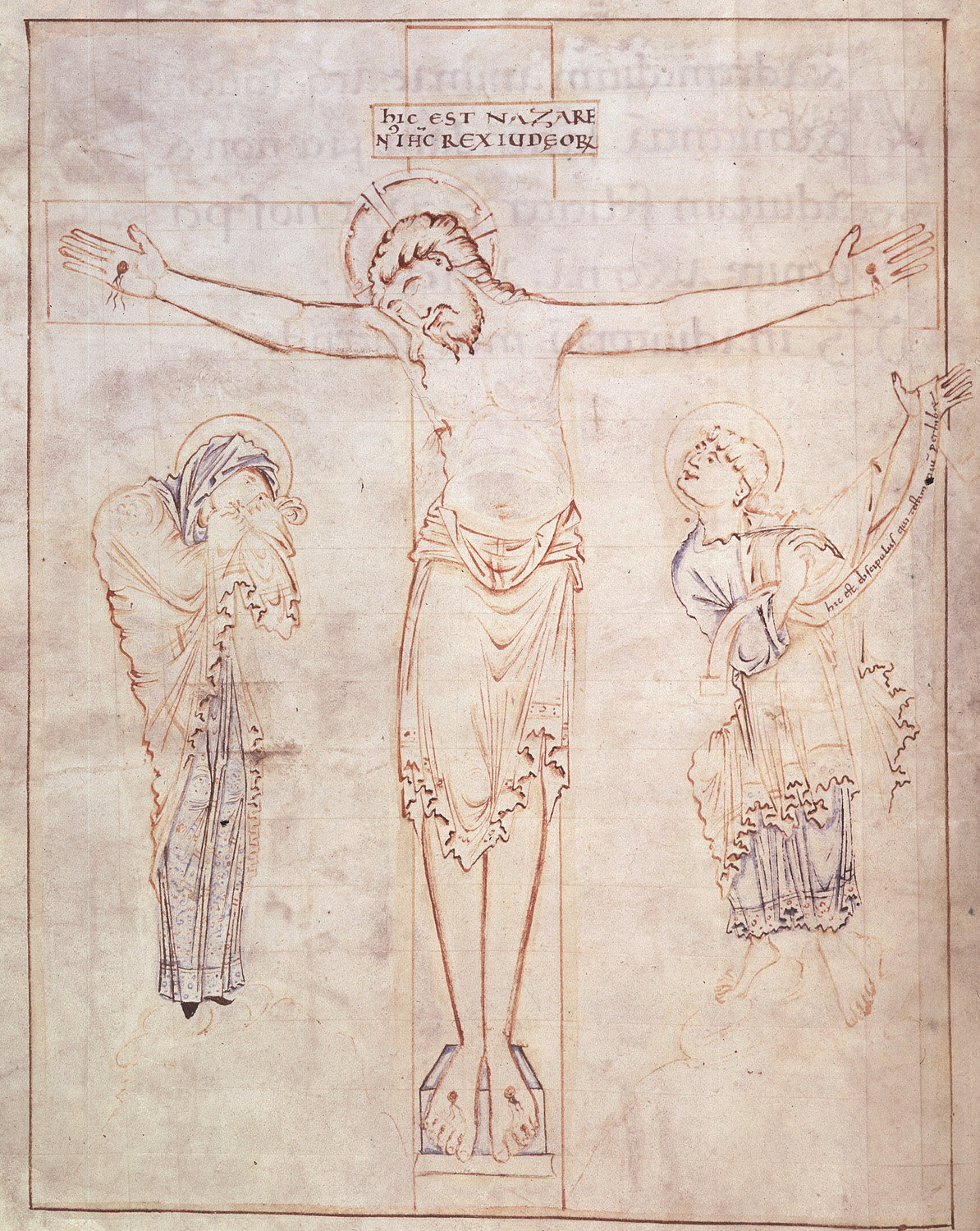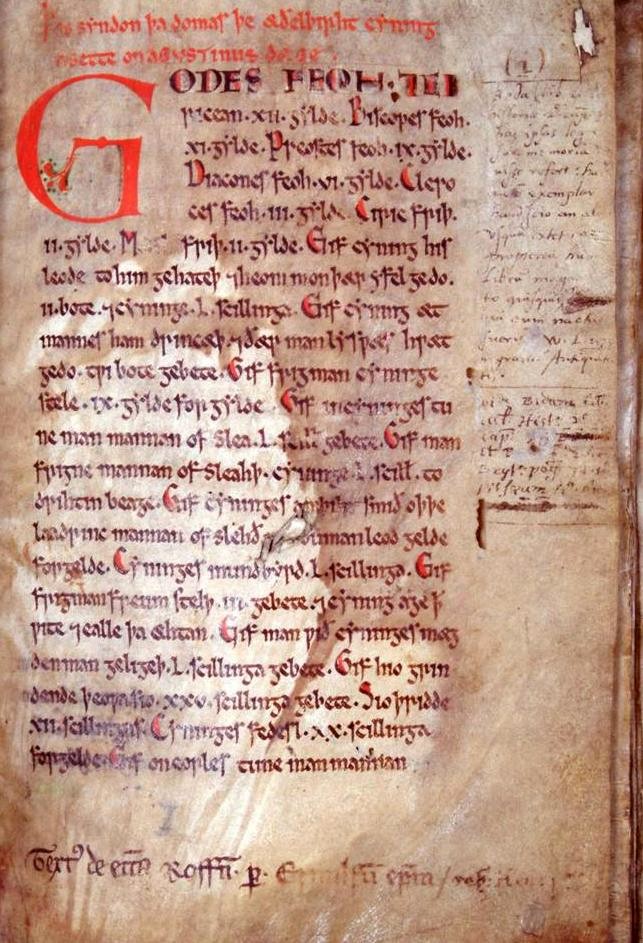|
Ecgberht Of Kent
Ecgberht I (also spelled Egbert) (died 4 July 673) was a King of Kent (664-673), succeeding his father Eorcenberht. He may have still been a child when he became king following his father's death on 14 July 664, because his mother Seaxburh was recorded as having been regent. Ecgberht's court seems to have had many diplomatic and ecclesiastic contacts. He hosted Wilfrid and Benedict Biscop, and provided escorts to Archbishop Theodore and Abbot Adrian of Canterbury for their travels in Gaul. The various versions of the Kentish Royal Legend state that, spurred on by his adviser Thunor, he had his cousins Æthelred and Æthelberht (sons of his uncle Eormenred) killed, and so had to pay Weregild to their sister Domne Eafe, enabling her to build a Monastery at Thanet; this may reflect a dynastic struggle that ended in the success of Eorcenberht's line. The two murdered princes were later venerated as saints at Ramsey Abbey in Huntingdonshire. A charter records Ecgberht's p ... [...More Info...] [...Related Items...] OR: [Wikipedia] [Google] [Baidu] |
Kingdom Of Kent
la, Regnum Cantuariorum , conventional_long_name = Kingdom of the Kentish , common_name = Kent , era = Heptarchy , status = vassal , status_text = , government_type = Monarchy , event_start = , date_start = , year_start = c. 455 , event_end = , date_end = , year_end = 871 , event1 = , date_event1 = , event2 = , date_event2 = , event3 = , date_event3 = , event4 = , date_event4 = , p1 = Sub-Roman Britain , flag_p1 = Vexilloid of the Roman Empire.svg , border_p1 = no , s1 = Kingdom of England , flag_s1 = Flag of Wessex.svg , border_s1 = no , image_coat = , symbol = , symbol_ty ... [...More Info...] [...Related Items...] OR: [Wikipedia] [Google] [Baidu] |
Ramsey Abbey
Ramsey Abbey was a Benedictine abbey in Ramsey, Huntingdonshire (now part of Cambridgeshire), England. It was founded about AD 969 and dissolved in 1539. The site of the abbey in Ramsey is now a Scheduled Ancient Monument. Most of the abbey's buildings were demolished after the dissolution but surviving structures are Grade I and Grade II* listed buildings. Ramsey Abbey Gatehouse is in the care of the National Trust and the Church of St Thomas à Becket, Ramsey was one of the buildings of the abbey. The Abbey Ramsey Abbey was founded in 969 by Oswald, Bishop of Worcester on land donated by Æthelwine, Ealdorman of East Anglia (Earl Ailwyn), where he had already built a wooden chapel for three monks. The foundation was part of the mid-10th century English Benedictine reform, in which Ely and Peterborough were also refounded. Æthelwine gave the new foundation properties including an estate at nearby Bodsey and Houghton Mill. The Frankish scholar Abbo of Fleury came t ... [...More Info...] [...Related Items...] OR: [Wikipedia] [Google] [Baidu] |
Medieval Child Rulers
In the history of Europe, the Middle Ages or medieval period lasted approximately from the late 5th to the late 15th centuries, similar to the post-classical period of global history. It began with the fall of the Western Roman Empire and transitioned into the Renaissance and the Age of Discovery. The Middle Ages is the middle period of the three traditional divisions of Western history: classical antiquity, the medieval period, and the modern period. The medieval period is itself subdivided into the Early, High, and Late Middle Ages. Population decline, counterurbanisation, the collapse of centralized authority, invasions, and mass migrations of tribes, which had begun in late antiquity, continued into the Early Middle Ages. The large-scale movements of the Migration Period, including various Germanic peoples, formed new kingdoms in what remained of the Western Roman Empire. In the 7th century, North Africa and the Middle East—most recently part of the Eastern R ... [...More Info...] [...Related Items...] OR: [Wikipedia] [Google] [Baidu] |
7th-century English Monarchs
The 7th century is the period from 601 (DCI) through 700 ( DCC) in accordance with the Julian calendar in the Common Era. The spread of Islam and the Muslim conquests began with the unification of Arabia by Muhammad starting in 622. After Muhammad's death in 632, Islam expanded beyond the Arabian Peninsula under the Rashidun Caliphate (632–661) and the Umayyad Caliphate (661–750). The Muslim conquest of Persia in the 7th century led to the downfall of the Sasanian Empire. Also conquered during the 7th century were Syria, Palestine, Armenia, Egypt, and North Africa. The Byzantine Empire suffered setbacks during the rapid expansion of the Caliphate, a mass incursion of Slavs in the Balkans which reduced its territorial limits. The decisive victory at the Siege of Constantinople in the 670s led the empire to retain Asia Minor which assured the existence of the empire. In the Iberian Peninsula, the 7th century was known as the ''Siglo de Concilios'' (century of counc ... [...More Info...] [...Related Items...] OR: [Wikipedia] [Google] [Baidu] |
673 Deaths
__NOTOC__ Year 673 ( DCLXXIII) was a common year starting on Saturday (link will display the full calendar) of the Julian calendar. The denomination 673 for this year has been used since the early medieval period, when the Anno Domini calendar era became the prevalent method in Europe for naming years. Events By place Europe * Spring – King Chlothar III of Neustria and Burgundy dies after a reign of 16 years, in which he has been a puppet — ''roi fainéant'' — of the Neustrian mayor of the palace, Ebroin. He is buried in the Basilica of St. Denis, and succeeded by his brother Theuderic III. * Burgundian nobles, under the leadership of bishop Leodegar and Adalrich, invite Childeric II to become king in Neustria and Burgundy.Patrick J. Geary, "Before France & Germany, The Creation & Transformation of the Merovingian World". New York, Oxford: Oxford University Press (1988), pp. 189–90 He invades Theuderic's kingdom and displaces his brother, becoming so ... [...More Info...] [...Related Items...] OR: [Wikipedia] [Google] [Baidu] |
Kentish Monarchs
Kentish may be used as a name: * Kentish Council is a local government area in Tasmania, Australia *Kentish Town is an area of north west London, England Kentish as a surname: * John Kentish (minister), 1768–1853 * John Kentish (tenor), 1910–2006, English opera singer Kentish may also be an adjective for things relating to the English county of Kent or the former Kingdom of Kent la, Regnum Cantuariorum , conventional_long_name = Kingdom of the Kentish , common_name = Kent , era = Heptarchy , status = vassal , status_text = , government_type = Monarchy ...: * Kentish dialect, the dialect of Modern English spoken in Kent * Kentish dialect (Old English), a dialect of Old English * Kentish Man or Maid * Old Kentish Carol, a traditional Christmas carol from Kent See also * Kent (other) * Kentish plover {{disambig ... [...More Info...] [...Related Items...] OR: [Wikipedia] [Google] [Baidu] |
Unwin Hyman
George Allen & Unwin was a British publishing company formed in 1911 when Sir Stanley Unwin purchased a controlling interest in George Allen & Co. It went on to become one of the leading publishers of the twentieth century and to establish an Australian subsidiary in 1976. In 1990, Allen & Unwin was sold to HarperCollins and the Australian branch was the subject of a management buy-out. George Allen & Unwin in the UK George Allen & Sons was established in 1871 by George Allen, with the backing of John Ruskin, becoming George Allen & Co. Ltd. in 1911 and then George Allen & Unwin in 1914 as a result of Stanley Unwin's purchase of a controlling interest. Unwin's son Rayner S. Unwin and nephew Philip helped run the company, which published the works of Bertrand Russell, Arthur Waley, Roald Dahl, Lancelot Hogben, and Thor Heyerdahl. It became well known as J. R. R. Tolkien's publisher, some time after publishing the popular children's fantasy novel '' The Hobbit'' in 1937, ... [...More Info...] [...Related Items...] OR: [Wikipedia] [Google] [Baidu] |
Bede
Bede ( ; ang, Bǣda , ; 672/326 May 735), also known as Saint Bede, The Venerable Bede, and Bede the Venerable ( la, Beda Venerabilis), was an English monk at the monastery of St Peter and its companion monastery of St Paul in the Kingdom of Northumbria of the Angles (contemporarily Monkwearmouth–Jarrow Abbey in Tyne and Wear, England). Born on lands belonging to the twin monastery of Monkwearmouth–Jarrow in present-day Tyne and Wear, Bede was sent to Monkwearmouth at the age of seven and later joined Abbot Ceolfrith at Jarrow. Both of them survived a plague that struck in 686 and killed a majority of the population there. While Bede spent most of his life in the monastery, he travelled to several abbeys and monasteries across the British Isles, even visiting the archbishop of York and King Ceolwulf of Northumbria. He was an author, teacher ( Alcuin was a student of one of his pupils), and scholar, and his most famous work, ''Ecclesiastical History of the English ... [...More Info...] [...Related Items...] OR: [Wikipedia] [Google] [Baidu] |
List Of Monarchs Of Kent
This is a list of the kings of the Anglo-Saxon Kingdom of Kent. The regnal dates for the earlier kings are known only from Bede. Some kings are known mainly from charters, of which several are forgeries, while others have been subjected to tampering in order to reconcile them with the erroneous king lists of chroniclers, baffled by blanks, and confused by concurrent reigns and kings with similar or identical names. It is commonplace for the later kings to be referred to as subkings, but the actual rank used is always ''rex'', never ''regulus'' (except for a late legend concerning Eormenred). The usual style was simply King of Kent (''rex Cantiae'') or King of the Kentish Men (''rex Cantuariorum''). Territorial division within Kent is not alluded to, except by Eadberht I (''rex Cantuariorum terram dimidii'') and Sigered (''rex dimidie partis prouincie Cantuariorum''). List of kings of Kent See also * List of English monarchs * Kentish Royal Legend * Anglo-Saxon royal genealo ... [...More Info...] [...Related Items...] OR: [Wikipedia] [Google] [Baidu] |
Wihtred Of Kent
Wihtred ( la, Wihtredus) ( – 23 April 725) was king of Kent from about 690 or 691 until his death. He was a son of Ecgberht I and a brother of Eadric. Wihtred ascended to the throne after a confused period in the 680s, which included a brief conquest of Kent by Cædwalla of Wessex, and subsequent dynastic conflicts. His immediate predecessor was Oswine, who was probably descended from Eadbald, though not through the same line as Wihtred. Shortly after the start of his reign, Wihtred issued a code of laws—the Law of Wihtred—that has been preserved in a manuscript known as the '' Textus Roffensis''. The laws pay a great deal of attention to the rights of the Church (of the time period), including punishment for irregular marriages and for pagan worship. Wihtred's long reign had few incidents recorded in the annals of the day. He was succeeded in 725 by his sons, Æthelberht II, Eadberht I, and Alric. Kent in the late seventh century The dominant force in ... [...More Info...] [...Related Items...] OR: [Wikipedia] [Google] [Baidu] |
Eadric Of Kent
Eadric (died August 686/ 687?) was a King of Kent (685–686). He was the son of Ecgberht I. Historical context In the 7th century the Kingdom of Kent had been politically stable for some time. According to Bede: Eorcenberht was succeeded by his sons Ecgberht (664-673) and Hlothhere (673-685). Ecgberht's court seems to have had many diplomatic and ecclesiastic contacts. He hosted Wilfrid and Benedict Biscop, and provided escorts to Archbishop Theodore and Abbot Adrian of Canterbury for their travels in Gaul. However, increasing dynastic tensions occurred at this time, when according to tradition Ecgberht had his cousins Æthelred and Æthelberht murdered, effectively removing them as they had a strong claim on the throne. Joint ruler of Kent? Hlothhere succeeded his brother as ruler of Kent in 673. It was not unusual for Kent to be divided between rulers at that time. However although there has been some suggestion that Eadric jointly ruled with his uncle Hlothher ... [...More Info...] [...Related Items...] OR: [Wikipedia] [Google] [Baidu] |
Hlothhere Of Kent
Hlothhere ( ang, Hloþhere; died 6 February 685) was a King of Kent who ruled from 673 to 685. Hlothhere succeeded his brother Ecgberht I in 673. His parents were Eorcenberht of Kent and Seaxburh of Ely, the daughter of Anna of East Anglia. In 676 the Mercian king Æthelred invaded Kent and caused great destruction;Bede, ''Ecclesiastical History'', IV, 12, p. 223. according to Bede, even churches and monasteries were not spared, and Rochester was laid waste. The damage was so great that Putta, Bishop of Rochester, resigned. So too did his successor, Cwichhelm, due to the poverty of the see. Hlothhere's rule survived this onslaught, however. He appears for a time to have reigned jointly with his nephew Eadric, son of Ecgberht I, since a code of laws still extant was issued under both their names.Oliver, Lisi. ''The Beginnings of English Law'', Toronto. Toronto University Press, 2002, pp. 126–27, 134 A law code, the Law of Hlothhere and Eadric, is jointly attributed ... [...More Info...] [...Related Items...] OR: [Wikipedia] [Google] [Baidu] |






